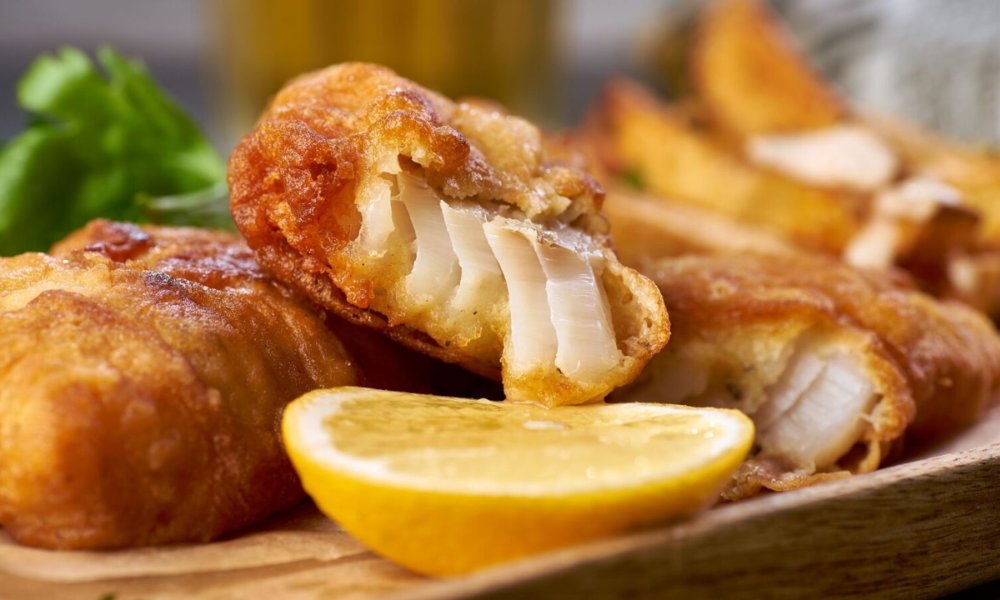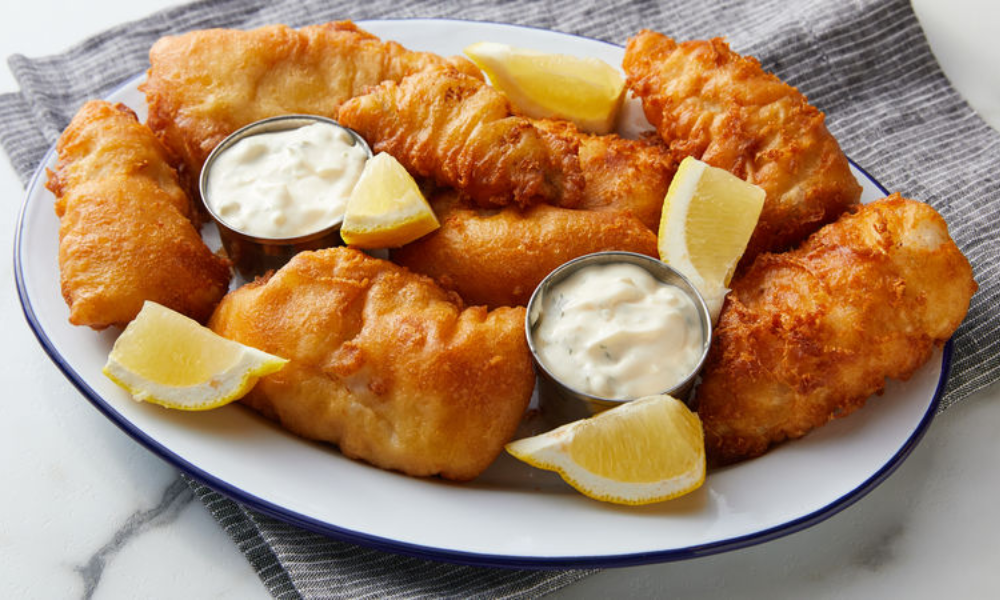A quick and simple protein choice that is low in fat is fish. This article includes a recipe for lemon-batter fish, a straightforward and delectable fish dish that will likely become a family favorite. The fish is coated in a fragrant lemon batter in this dish before being deep-fried to golden-crisp perfection.
The recipe also calls for a straightforward tartar sauce, which goes incredibly well with the fish’s crunchy, lemony flavor. This recipe is simple to follow and certain to please whether you are an experienced cook or a novice in the kitchen. So gather your ingredients, and prepare to tuck into a delicious and filling fish lunch in a lemon batter.
Lemon-Batter Fish Recipe
Ingredients:
- 1 pound white fish fillets (such as cod, haddock, or tilapia)
- 1 cup all-purpose flour
- One teaspoon of baking powder
- 1/2 teaspoon salt
- 1 cup cold water
- Two tablespoons of lemon juice
- Vegetable oil for frying
For the Tartar Sauce:
- 1/2 cup mayonnaise
- One tablespoon of diced dill pickles
- One tablespoon diced red onion
- One tablespoon of diced capers
- One teaspoon of lemon juice
- Salt and pepper, to taste
Instructions:
- Mix the salt, baking powder, and flour in a medium bowl.
- Whisk till smooth before gradually adding the cold water and lemon juice.
- A big skillet should be heated at medium-high. Fill the skillet with vegetable oil to a depth of 1/2 inch.
- Coat the fish fillets evenly with the batter by dipping them in.
- After being battered, the fish should be cooked thoroughly and golden brown when placed in the hot oil.
- Fish should be taken out of the skillet and drained on a plate lined with paper towels.
- To make the tartar sauce, combine the mayonnaise, pickles, red onion, capers, and lemon juice in a small bowl. To taste, add salt and pepper to the food.
- With the tartar sauce on the side, serve the fish in lemon batter. Enjoy!
There are four servings in this recipe. Depending on the number of guests, you can alter the quantity of fish and batter as necessary. The lemon-batter fish is best served with tartar sauce, but you can also serve it with your dipping sauce or condiment. Cod, haddock, or tilapia are a few examples of white fish fillets that can be used in this dish.
How do I Get the Batter to Stick to My Fish?:
Here are some pointers you can use to help the batter adhere to your fish:
Use paper towels to pat the fish dry. Make sure the fish is completely dry before battering it. The batter might not adhere as well to moist fish.
Use a thick batter since it will adhere to the fish more effectively than a thin one. By adjusting the amount of flour or water used, you can change the batter’s consistency.
Evenly coat the fish: Be sure to totally and evenly coat the fish with the batter. The batter may not adhere as effectively to the fish if it is not evenly coated.
Rest the batter: If you have the time, you can wait a few minutes before coating the fish with the batter. As a result, the batter will thicken and absorb more liquid, making it easier for the batter to adhere to the fish.
Exercise gentleness and a soft touch when dipping the fish into the batter. Overbearing pressure may cause the fish’s batter to come off.
These pointers will help you obtain flawlessly coated, crispy fried fish by getting the batter to adhere to your fish.
What is the Best Fish for Battering?
Any white fish, such as cod, haddock, tilapia, and pollock, can be battered and fried. These fish varieties have a robust, flaky texture that withstands battering and frying nicely. Additionally, they have a moderate, adaptable flavor that goes well with a wide range of sauces and seasonings.
Other fish varieties, such as salmon, tuna, and swordfish, can also be battered and fried, but their flavor and fishy flavor could be stronger. The strong frying heat can often dominate the flavor of some kinds of fish, so grilling or baking are the best options.
When choosing fish for battering and frying, fresh, high-quality fish should be chosen. Choose fillets that feel firm and are the same color throughout.
Avoid fish that smells bad, looks dry or is mushy. Fresh fish is the finest option for battering and frying since it has a gentle, sweet aroma.
Why do People Add Lemon to Fish?
There are a few reasons for adding lemon to fish:
Lemon gives fish a fresh, tart flavor that might help counteract the richness of the fish. A burst of citrusy freshness that complements the delicate, mild flavor of a wide variety of fish is also added.
Aesthetically, lemon can enhance the appearance of fish dishes since its vivid yellow color contrasts beautifully with the white or light-colored fish flesh.
Health benefits: Lemon has been demonstrated to improve digestion and strengthen the immune system potentially. It is also a good source of vitamin C and other nutrients. Fish might have more nutritional value when lemon is added to the dish.
Because of its flavor, aesthetic appeal, and potential health benefits, lemon is preferred in many fish meals. It can be used to season fish in various ways, such as a garnish, a marinade, or something squeezed over the top of the fish.
Which Flour is the Best for the Batter?
The best flour to use while creating batter is all-purpose flour. It is a flexible and generally accessible flour that is excellent for various fried items due to its neutral flavor and modest protein content. Self-rising bread and cake flour are among the other types of flour that can be used to make the batter, but all-purpose flour is the most widely used and will generally yield satisfactory results.
What Makes Batter More Crispy?
You can use the following advice to make the batter more crispy:
- Use cold water to maintain the lightness and crispness of the batter.
- Use a thick batter since it will give the meal a crispier, crunchier coating.
- Exercise gentleness and a soft touch when coating the food in the batter. You risk squeezing the batter off the meal if you press too firmly.
- Use a high-heat frying oil: High-heat cooking oils can assist in producing a crispier, crunchier texture. Examples include vegetable oil or canola oil.
- Preheating the oil will ensure that it is hot enough to cook the food fast and produce a crisp coating. Make sure to do this before frying any food.
How to Fry Fish in a Deep Fryer?
You’ll need a deep fryer, cooking oil, and the fish you wish to fry to deep fry fish. Here is a step-by-step tutorial for deep-frying fish:
Heat the oil: Heat the oil by adding it to the deep fryer as directed by the manufacturer. The oil should be heated to the desired temperature. Most deep fryers contain an internal thermostat that keeps the oil at the right temperature.
Prepare the fish: Fish preparation involves rinsing and drying the fish using paper towels. If you’re using thick fillets or whole fish, chop them into manageable-sized pieces before placing them in the deep fryer.
Batter or breading the fish: If you’re using a batter or breading, coat the fish completely and evenly.
Put the fish in the fryer: Use tongs or slotted spoon to place the fish in the heated oil carefully. The oil temperature can drop if the fryer is overcrowded, resulting in mushy and overcooked fish.
Cook the fish: Cook the fish as directed by the manufacturer or until it reaches the level of doneness you prefer. This will take between 5 and 8 minutes for the majority of fish kinds.
Remove the fish from the fryer: Use tongs or a slotted spoon to carefully remove it and set it on a plate covered with paper towels to drain any excess oil.
Do you Flip Fish When Frying?
Fish doesn’t usually need to be turned over when frying because the oil’s heat uniformly cooks the fish on both sides. Fish is fried when cooked in a pan or deep fryer with hot oil and is often left to cook until it is fully done.
Typically, the fish is added to the oil with tongs or a slotted spoon and cooked until it reaches the appropriate degree of doneness.
To ensure that the fish is cooked uniformly on all sides when frying larger fish pieces, such as whole fish or thick fillets, you might need to turn the fish halfway through cooking. Flipping is not necessary for most small or thin fish fillets, though.
Always keep an eye on the fish while it cooks to ensure it doesn’t burn or become overdone. For the greatest results, it’s crucial to adhere to the manufacturer’s recommendations while using a deep fryer.
Conclusion
This Lemon-Batter Fish is an easy recipe that is perfect for a weekday meal or a weekend lunch since it is delicious. After being coated in a lemon-flavored batter that is light and crisp, the fish is then fried until it reaches the desired level of doneness. A touch of lemon juice and a side dish of your choosing are included with the dish when it is served.

